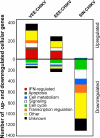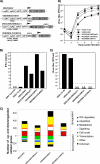Design of chimeric alphaviruses with a programmed, attenuated, cell type-restricted phenotype
- PMID: 21345954
- PMCID: PMC3126257
- DOI: 10.1128/JVI.00065-11
Design of chimeric alphaviruses with a programmed, attenuated, cell type-restricted phenotype
Abstract
The Alphavirus genus in the Togaviridae family contains a number of human and animal pathogens. The importance of alphaviruses has been strongly underappreciated; however, epidemics of chikungunya virus (CHIKV), causing millions of cases of severe and often persistent arthritis in the Indian subcontinent, have raised their profile in recent years. In spite of a continuous public health threat, to date no licensed vaccines have been developed for alphavirus infections. In this study, we have applied an accumulated knowledge about the mechanism of alphavirus replication and protein function in virus-host interactions to introduce a new approach in designing attenuated alphaviruses. These variants were constructed from genes derived from different, geographically isolated viruses. The resulting viable variants encoded CHIKV envelope and, in contrast to naturally circulating viruses, lacked the important contributors to viral pathogenesis: genes encoding proteins functioning in inhibition of cellular transcription and downregulation of the cellular antiviral response. To make these viruses incapable of transmission by mosquito vectors and to differentially regulate expression of viral structural proteins, their replication was made dependent on the internal ribosome entry sites, derived from other positive-polarity RNA (RNA(+)) viruses. The rational design of the genomes was complemented by selection procedures, which adapted viruses to replication in tissue culture and produced variants which (i) demonstrated different levels of replication and production of the individual structural proteins, (ii) efficiently induced the antiviral response in infected cells, (iii) were incapable of replication in cells of mosquito origin, and (iv) efficiently replicated in Vero cells. This modular approach to genome design is applicable for the construction of other alphaviruses with a programmed, irreversibly attenuated phenotype.
Figures









References
Publication types
MeSH terms
Substances
Grants and funding
LinkOut - more resources
Full Text Sources
Other Literature Sources
Medical

